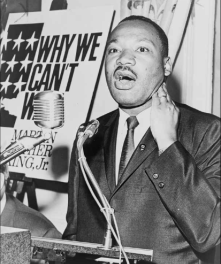By Roy S. Johnson

acres of facilities and open land, Alabama Shipyard has a lot of room for business growth.
(Courtesy of Alabama Shipyard)
This is an opinion column.
Movements are often launched by a moment, seismic change by a single calamity. Or crime.
Three years ago, on this day, George Floyd, a 46-year-old Black man, a father, a son, an uncle, and a man, died beneath the knee of Milwaukee police officer Derek Chauvin. Died as his neck was crushed. Died while calling for his mother.
His death changed us. Some for the better, yanking the oblivious into the obvious—into the hell of police violence against Black people that too many for too long ignored. Too long shied away, shielded themselves, and into a cocoon that was shattered. Shattered on this day three years ago.
It changed our consciousness. It released a reckoning (too short-lived as it may have been, but let’s not dwell on that today. Not today). It made us matter.
Not to all, alas. In some, Floyd’s death unleashed the worse, bless their stony hearts. Unleashed their hatred, their ignorance — but let’s not dwell on that today, either. Not today.
Today, let’s memorialize the moments of this day and ponder the movements they inspired.
Throughout World Wars I and II, the Alabama Drydock and Shipbuilding Company in Mobile was a vital stalwart, producing and servicing U.S. Naval ships deployed in the efforts. At one juncture, it was the city’s largest employer, although, until 1941, all its workers were white. That year, it began hiring Blacks. Although the African Americans were placed in low-wage unskilled gigs, their presence still irked many white workers.
The hirings were sparked by President Franklin Roosevelt’s Executive Order 8802, issued on June 25, 1941, in response to demands from the Brotherhood of Sleeping Car Porters’ President A. Philip Randolph, an iconic labor leader, and other Black leaders, to stop discrimination in the defense industry. After meetings with the president, his wife Eleanor, and members of the cabinet, the order declared, “There shall be no discrimination in the employment of workers in defense industries and government, because of race, creed, color, or national origin.”
It was the first presidential order on race/racism in decades—the first since Reconstruction.
By 1943, 7,000 of Alabama Drydock and Shipbuilding’s 50,000 employees were Black.
Then, on this day that year, all hell broke loose.
On this day, on May 25, 1943, just after the company promoted 12 — just 12! — Black workers to welder, a position previously reserved for whites, a reported 4,000 white employees and locals began attacking any Black employee they saw, beating them with pipes and anything else they could weaponize. The Black welders had just completed their first shift with the attacks began.
Two Black men were thrown into the Mobile River, others leaped in to save themselves.
The National Guard diffused the mob — after more than 50 Blacks were severely hurt. No one, thankfully, was killed.
Eventually, the company created four segregated shipyards. On the all-Black yards, Blacks could work in any role — except foreman. Except boss.
The attack, that moment, inspired similar violence in other industries and eventually sparked, some believe, another moment that changed us.
It inspired efforts to desegregate other areas of life, including restaurants, theaters, and public transportation.
Just over a decade later, in 1955, a woman refused to leave her seat on a but in Montgomery. Another moment that lifted a movement.
In 1963, two decades after Black shipyard workers in Mobile were attacked, after Black men there were attacked for simply trying to work, after Black men had to leap overboard to save their lives — a Klan bombing in Birmingham that stole young lives, firehouses were aimed at young Black boys and girls who just wanted to shop, and eat, and have a side where they chose.
So many moments — so many calamities, so many crimes — changed us, ignited us.
A year later, the Civil Rights Act of 1964 was signed, ending legal segregation in public facilities.
And yet we still must move. We still need movements.
I don’t the names of any of the Black workers, the Black men who feared for their lives on the Mobile shipyard 80 years ago. Haven’t seen them recorded anywhere. (If one of them was your relative, please let me know; if you’re related to one of the white workers who worked on the shipyard that day, I’d love to know that, too.)
Alabama Drydock and Shipbuilding all but died in the 1970s, imploding beneath changing times and lingering labor matters. In 2018, it had fewer than a dozen employees when it was acquired by a group of new investors.
Last year, the U.S. Navy Ship Comfort was docked in the shipyard as part of a $26 million dry-docking and overhaul.
Earlier this month, the shipyard announced receiving a $718,244 grant from the U.S. Department of Transportation as part of its $20.8 million Shipyard Grant Program to support 27 facilities nationwide. Alabama Shipyard LLC said it will match the funds and use the $1.5 million total to purchase air compressor systems and fire suppression pumps.
Today, I think about the Black men who were there. Who were there simply trying to live—and who may, in a moment of fear, have inspired a movement.











